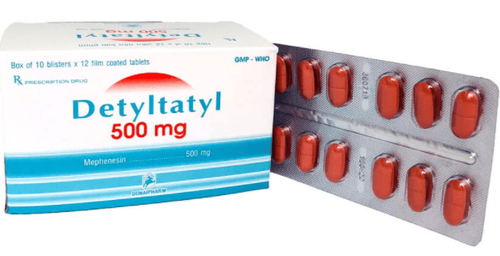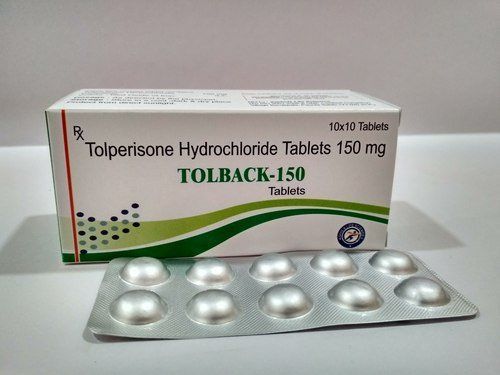This is an automatically translated article.
Sirvasc is used in the symptomatic treatment of muscle cramps and spasticity caused by multiple sclerosis or spinal cord injury. The following article provides you with information about the uses and dosages of Sirvasc.1. What are the effects of Sirvasc?
Sirvasc has the main active ingredient is Tizanidine, the drug is prepared in the form of tablets with a content of 2mg.Tizanidine is an alpha2 - adrenergic agonist, acting on the central nervous system of the spinal cord and on the spinal cord. Tizanidine increases presynaptic inhibition of motor neurons at alpha2-adrenergic receptors, possibly by reducing excitatory amino acid release and inhibiting caeruleospinal excitability, which leads to a reduction in spasticity. Some studies suggest that tizanidine may act postsynaptic at excitatory aminoacid receptors. In addition, Tizanidine may act at the imidazole receptor. Tizanidine acts mainly on neurons with many synapses, so Tizanidine reduces the excitability of motor neurons in the spinal cord, so it reduces muscle contraction and does not cause excessive muscle weakness.
In experimental animal studies, Tizanidine has no direct effects on neuromuscular or skeletal muscle fibers. Tizanidine also has a mild effect on single-synaptic reflexes, thus having a caeruleospinal stimulant effect. The exact mechanism of action of Tizanidine is still unknown. Tizanidine also has a blood pressure-lowering effect, possibly due to its binding to the Imidazolin receptor. In animals, tizanidine has a blood pressure lowering activity of 1/15 - 1/10 of clonidine, which is an alpha2 - adrenergic agonist. The antihypertensive effect of T is mild and transient, related to the drug's muscle relaxant activity.
Tinazidine also has an antisensitizing effect, which is produced through the alpha2-adrenergic receptor mechanism. The dose of tizanidine with an established antisensitization effect was lower than that of the muscle relaxant.
Several different studies show that Tizanidine also has antipyretic, anticonvulsant, gastrointestinal effects and sympathomimetic inhibition.
2. Indications and contraindications to the use of Sirvasc
Sirvasc is indicated in the following cases:
Muscle spasm causing pain due to dysfunction or posture of the spine: Neck curvature, pain around the shoulder, low back pain; after surgery (osteoarthritis, disc herniation). Neurological spasticity: Multiple sclerosis or chronic spinal cord disease. Contraindications:
Hypersensitivity to Tizanidine or any component of Sirvasc. Do not take Sirvasc and Ciprofloxacin or Fluvoxamine at the same time. Patients with severe liver failure.
3. How to take Sirvasc
Sirvasc is taken orally. The time of taking the medicine may not be related to the meal, but the way of taking it should not be changed. Switching from taking Tizanidine with a meal to taking it outside of a meal may slow or speed up the duration of action of Tizanidine. Adjust the dose of Sirvasc according to the patient's condition and response. Dosage of Sirvasc is as follows:
Pain due to muscle contraction: Dosage 2 - 4mg x 3 times/day. Muscle spasticity due to neurological disorders: Dosage 6mg/day, divided into 3 times/day. Then, depending on the patient's response, the dose can be increased to 12 - 36mg/day, the maximum dose is 36mg/day. Overdosage of Sirvasc and management:
Overdosage of Tizanidine may cause hypotension, bradycardia, dizziness, pupillary constriction, coma, nausea, vomiting, altered mental status, confusion and especially respiratory failure.
Use general poisoning treatment methods to help eliminate Tizanidine such as gastric lavage, activated charcoal and diuretics such as Mannitol, Furosemide. In addition, apply symptomatic and supportive measures.
Patient monitoring: monitoring vital signs, continuous cardiac and electrocardiographic monitoring, respiratory and central nervous system function, fluid and electrolyte balance. Tizanidine is not eliminated from the systemic circulation by dialysis because of its large volume of distribution.
4. Be careful when using Sirvasc
On the cardiovascular system and blood pressure: Tizanidine may prolong the QT interval on the electrocardiogram. Tizanidine may cause hypotension, which is dose-dependent. Sudden position changes may increase the risk of orthostatic hypotension.
Patients with impaired liver function: Tizanidine may cause liver damage, need to monitor serum aminotransferases during the first 6 months of taking the drug (at 1, 3, 6) and then periodically depending on the clinical condition. patient's readiness.
Ability to drive, use machines: Tizanidine has a sedative effect and may cause drowsiness. Use caution when using the drug in people who do jobs that require alertness such as driving or operating machinery.
Use Sirvasc with caution in patients: Patients with renal failure, the elderly, children under 18 years of age, pregnant and lactating women..
5. Undesirable effects when using Sirvasc
Using Sirvasc, you may experience some of the following undesirable effects:
Common: Low blood pressure, somnolence, dizziness, weakness, dry mouth. Very common: Bradycardia, drowsiness, fatigue, anxiety, depression, paranoia, agitation, speech disturbances, abdominal pain, diarrhea, constipation, nausea, vomiting. Back pain, myasthenia gravis, paresthesia, dyskinesia. Increase liver enzymes. Uncommon: Orthostatic hypotension, vasodilation, syncope, arrhythmia, migraine. Difficulty swallowing, gallstones, gastrointestinal bleeding, hepatitis. Tremor, agitation, paralysis, thought disorder, convulsions, dizziness, lightheadedness, dreams, peripheral neuritis. Rare: Myocardial infarction, adrenal insufficiency, dementia, hemiplegia. When experiencing any unwanted side effects during the use of Sirvasc, patients should consult their doctor for timely treatment.
6. Drug interactions
Inhibitors of CYP1A2, including acyclovir, antiarrhythmics, cimetidine, famotidine, fluvoxamine, fluoroquinolones, oral contraceptives, ticlopidine and zileuton: Avoid concomitant use with tizanidine due to decreased clearance of the drug in plasma. Drugs that cause hypotension: Caution should be taken when co-administering these drugs because tizanidine also has a blood pressure-lowering effect. Beta-adrenergic blocking agents and digoxin: Concomitant use with tizanidine requires caution due to the risk of hypotension and bradycardia. Oral contraceptives reduce Tizanidine clearance by approximately 50%, thereby increasing the side effects of Tizanidine. Tizanidine when co-administered with alcohol or other CNS depressants (Dantrolen, Diazepam) has synergistic CNS depressant effects. Ciprofloxacin, Fluvoxamine: Increases Tizanidine plasma concentrations, increasing the risk of adverse cardiovascular and CNS effects. Concomitant use of Sirvasc with these drugs is contraindicated. The basic information about Sirvasc in the above article is for reference only. Because Sirvasc is a prescription drug, patients should not use it on their own, but need to contact a specialist directly for a suitable prescription to ensure safety for health.













